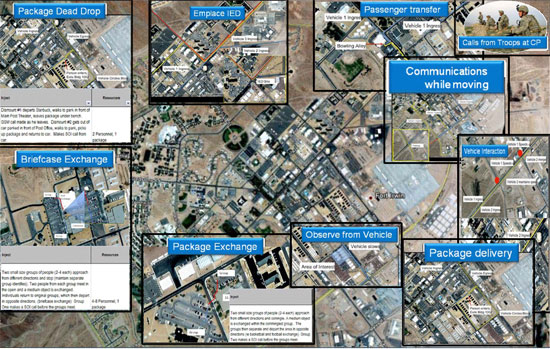Big Brother is Watching You – For Real (2)
Read the first part of the article

The CIA’s In-Q-Tel, SAIC, and Leidos
In 1998, the CIA identified technology as a top strategic priority, and set out a bold and radical plan to create a new venture that would help increase the agency’s access to private sector innovation. In-Q-Tel was chartered in February 1999 by a group of private citizens at the request of the Director of the CIA and with the support of the U.S. Congress. In-Q-Tel was tasked with building a bridge between the intelligence community and a new set of technology innovators. Eventually, In-Q-Tel evolved into the Science Applications International Corporation (SAIC).
Leidos, a joint spin-off of Science Applications International Corporation (SAIC), is an American defense company headquartered in Reston, Virginia, that provides scientific, engineering, systems integration, and technical services. Leidos works extensively with the Department of Defense (4th largest DoD contractor FY2012), the Department of Homeland Security, and the United States Intelligence Community, including the NSA, as well as other US government civil agencies and selected commercial markets. On September 27, 2013, SAIC changed its name to Leidos and spun off a $4 billion government services and information technology company, which retains the name Science Applications International Corporation.
SAIC Projects
In March 2001, SAIC defined the concept for the NSA Trailblazer Project. Trailblazer was a continuation of the earlier ThinThread program which was a project that the NSA pursued during the 1990s. The program involved wiretapping and sophisticated analysis of the resulting data. ThinThread was dismissed and replaced by the Trailblazer Project, which lacked privacy protections. A consortium led by SAIC was awarded a $280 million contract to develop Trailblazer in 2002.
Trailblazer was intended to develop a capability to analyze data carried on all communications networks. It was specifically intended to track entities using cell phones and e-mail. In 2002, NSA contracted SAIC for $280 million to produce a “technology demonstration platform” for the agency’s project, a “Digital Network Intelligence” system to analyze data carried on computer networks.
Cyberspace – A New Operational Domain
In 2011, the United States Department of Defense named cyberspace a new operational domain. The cyberspace domain provides critical capabilities that enable the military to conduct operations in all domains (Land, Sea, Air, Space, and Cyberspace). The US Cyber Command and the Military Services are working to integrate the cyberspace domain with the other operational domains in order to conduct military command and control and achieve “national security” objectives.
To effectively integrate cyberspace operations, DoD requires situational awareness of the “Mission”, “Network”, and “Adversary” based on analysis of operational data to make timely and effective decisions. It is official, every time you are on the internet, you are in a cyber war-zone as defining by the US Department of Defense. You are considered a “hostile actor” until neutralized.
NSA Cyber-kinetic Attacks
The military has for years been developing offensive capabilities, giving it the power not just to defend the US but to assail its foes. Using so-called cyber-kinetic attacks, the NSA and its forces now have the capability to physically destroy an adversary’s equipment and infrastructure, and potentially even to kill. The NSA has concluded that such cyber weapons are as crucial to 21st-century warfare as nuclear arms were in the 20th.
Cyber warriors have already launched their first attack. The cyber-weapon that came to be known as Stuxnet was created and built by the NSA in partnership with the CIA and Israeli intelligence in the mid-2000s. The first known piece of malware designed to destroy physical equipment, Stuxnet was aimed at Iran’s nuclear facility in Natanz. By surreptitiously taking control of an industrial control link known as a Scada (Supervisory Control and Data Acquisition) system, the sophisticated worm damaged about a thousand centrifuges used to enrich nuclear material.
But Stuxnet is only the beginning. The NSA has recruited thousands of computer experts, hackers, and engineering PhDs to expand US offensive capabilities in the digital realm. The Pentagon has requested $4.7 billion for “cyberspace operations,” even as the budget of the CIA and other intelligence agencies could fall by $4.4 billion. It is pouring millions into cyber defense contractors. And more attacks may be planned.
On a remote stretch of desert in central Utah, the NSA has built a massive, 1 million-square-foot data warehouse. Costing more than $1.5 billion, the highly secret facility is designed to house upward of trillions of intercepted phone calls, e-mail messages, Internet searches and other communications intercepted by the agency as part of its expansive eavesdropping operations. The NSA is also completing work on another data warehouse, this one in San Antonio, Texas.
Microsoft shares zero day vulnerabilities in its products with the NSA before releasing a public alert or a software patch. McAfee, the internet security company owned by Intel, provides the NSA, the CIA, and the FBI with network traffic flows, analysis of malware, and information about hacking trends.
Companies that promise to disclose holes in their products only to the spy agencies are paid for their silence. To an extent, these openings for government surveillance are required by law. Telecommunications companies, in particular, must build their equipment in such a way that it can be tapped by a law enforcement agency presenting a court order.
Description of Psyops from a Military Document
The document Intelligence and Electronic Warfare Support to Psychological Operations is based upon Special Operations Forces Intelligence and Electronic Warfare Operations, Field Manual No. 34-36 published on 30 September, 1991, by Department of the Army Headquarters in Washington DC, acknowledges:
“Missions

PSYOP missions are planned products and psychological actions in peace or war that are directed toward foreign enemy, friendly, and neutral audiences. The purpose is to influence attitudes and behaviors to achieve national political and military objectives.
PSYOP supports varied military, political, and diplomatic actions across the operational continuum. These missions can be strategic, operational, or tactical missions.
Strategic PSYOP missions are conducted at the national or theater level to advance broad, long-term psychological objectives in support of national psychological objectives.”
What New Evil is the Highlands Forum Up to Now
By 2008, the NSA was effectively resurrecting the Total Information Awareness project with a focus on internet data-mining via comprehensive monitoring of e-mails, text messages, and web browsing. We also now know that the NSA’s XKeyscore ‘Digital Network Intelligence’ exploitation system was designed to allow analysts to search not just internet databases like emails, online chats and browsing history, but also telephone services, mobile phone audio, financial transactions and global air transport communications – essentially the entire global telecommunications grid.
In 2009, it also emerged from a Google patent application that the company had deliberately been collecting ‘payload’ data from private wi-fi networks that would enable the identification of “geolocations.” In the same year, Google had signed an agreement with the NSA giving the agency open-ended access to the personal information of its users, and its hardware and software, in the name of cyber security.
It is not just Google that is a key contributor and foundation of the US military-industrial complex – it is the entire internet, and the wide range of private sector companies – many nurtured and funded under the mantle of the US intelligence community which sustain the internet and the telecoms infrastructure. It is also the myriad of start-ups selling cutting edge technologies to the CIA’s venture firm In-Q-Tel, where they can then be adapted and advanced for applications across the military intelligence community.
In 2011, the Forum hosted two DARPA-funded scientists, Antonio and Hanna Damasio, who are principal investigators in the ‘Neurobiology of Narrative Framing’ project at the University of Southern California. Evoking Zalman’s emphasis on the need for Pentagon psychological operations to deploy “empathetic influence”, the new DARPA-backed project aims to investigate how narratives often appeal “to strong, sacred values in order to evoke an emotional response,” but in different ways across different cultures.
The most disturbing element of the research is its focus on trying to understand how to increase the Pentagon’s capacity to deploy narratives that influence listeners in a way that overrides conventional reasoning in the context of morally-questionable actions.
DARPA’s goal is to mine millions of American weblogs as part of its ‘neurobiology of narrative framing’ research. As the Pentagon’s extensive funding of propaganda on Iraq and Afghanistan demonstrates, population influence and propaganda is critical not just in far-flung theatres abroad in strategic regions, but also at home, to quell the risk of domestic public opinion undermining the legitimacy of Pentagon policy.
Controlling Americans Through the Internet
It is important to remember that since Barack Obama added new language in the National Defense Authorization Act of 2012, Americans are now seen as possible terrorists and thus are military targets and enemies of the state, unless proven otherwise. In essence, all of the above cyberwarfare programs are being used on Americans indiscriminately and with ill intent.
The Patriot Act, later called the US Freedom Act is the exact opposite of its name – it takes away freedom from patriots and lets multi-national corporations and the “run-away military” use the American people as cyberwarfare testing grounds.
This fact is little known, that the US military is now allowed to act within the borders of America and target Americans as hostile war-actors (as the military calls these people).
US citizens are in an information war and the stakes are high – American freedom or military/corporate control. This battle wages while many people are complacent and perfectly happy with their addiction to their cellphone, the internet, and social media. Many mindless followers can’t wait until every electronic devise they own is connected to the Internet of Things.
The Internet is a weapon and it is our job to find out what the battle is all about and make sure that we retain our civil rights and freedom and liberty.
Americans would be necessary to call out DARPA and In-Q-Tel for their patent thefts, continuous lies, and cyberwarfare manipulations and demand that taxpayer dollars that funded these evil weaponized tools be acknowledge and that those cyber-tools be turned over to Americans without the spy systems and information control systems attached.
Americans need free and private internet and social networks that are not manipulated as a tool that intends to control people’s very thinking.
Remember that the intent is to “master the human domain” via the mechanical domain controlled by warlords who wish to take our freedoms away.
It is necessary for people to demand that these companies (and any others like them) that were financially seeded and funded by taxpayers, BE GIVEN TO THE PEOPLE AS A PUBLIC UTILITY and that the fictitious owners of these companies be prosecuted for patent infringement.
DARPA Programs
Below is a short list of DARPA/In-Q-Tel projects that have been declassified. This is just the tip of the iceberg. Just imagine, if they are willing to declassify programs about mind-control and psyops, what are the programs and projects that they are not willing to share with us. This list is daunting, frightful, and disturbing.
Social Media in Strategic Communication (SMISC) program is an attempt to get better at both detecting and conducting propaganda campaigns on social media. SMISC has two goals. First, the program needs to help the military better understand what’s going on in social media in real time – particularly in areas where troops are deployed. Second, Darpa wants SMISC to help the military play the social media propaganda game itself. The Pentagon is building a tool to identify social media propaganda campaigns that produces counter-spin through computer artificial intelligence.
Interactive Facial Recognition in Real Time – BBC facial recognition programs help predict the success or failure of television programming. In the past, the BBC has used its facial recognition technology, built by in-house startup CrowdEmotion, to track 4,500 faces as people watched show trailers to see what kinds of emotions the commercials produced. They’ve also looked at how hundreds of study participants react to programs like Top Gear and Sherlock.

The company CrowdSight uses facial recognition software in real time. They advertise on their website: “Understand and Predict your Audience! Deliver Better Experiences by Knowing their Emotional Behavior and Engagement in Real-time. CrowdSight Software Development Kit (SDK) is a flexible and easy-to-integrate Crowd Face Analysis Software which allows you to gather real-time, anonymous information about your audience while they behave spontaneously in different life environments. Understand your audience emotional reactions and engagement towards your products, content and campaigns, and recognize important demographics such as age, gender and ethnicity, in real-time. CrowdSight works offline and on the most popular desktop and mobile platforms (Windows, Mac, Linux, iOS, Android).”
Visual Evoked Potential (VEP) – A VEP is an electrical potential recorded after a subject is presented with a type of visual stimuli. There are several types of VEPs. Steady-state visually evoked potentials (SSVEPs) use potentials generated by exciting the retina, using visual stimuli modulated at certain frequencies. SSVEP’s stimuli are often formed from alternating checkerboard patterns and at times simply use flashing images. SSVEP has proved to be successful within many BCI systems. This is due to several factors, the signal elicited is measurable in as large a population as the transient VEP and blink movement and electro-cardiographic artefacts do not affect the frequencies monitored.
Synthetic Telepathy and Silent Communication – In a $6.3 million Army initiative to invent devices for telepathic communication, Gerwin Schalk, underwritten in a $2.2 million grant, found that it is possible to use ECoG signals to discriminate the vowels and consonants embedded in spoken and in imagined words. The results shed light on the distinct mechanisms associated with production of vowels and consonants, and could provide the basis for brain-based communication using imagined speech. Research into synthetic telepathy using sub-vocalization is taking place at the University of California, Irvine under lead scientist Mike D’Zmura. The first such communication took place in the 1960s using EEG to create Morse code using brain alpha waves.
Using EEG to communicate imagined speech is less accurate than the invasive method of placing an electrode between the skull and the brain. On February 27, 2013 the group of Miguel Nicolelis at Duke University and IINN-ELS successfully connected the brains of two rats with electronic interfaces that allowed them to directly share information, in the first-ever direct brain-to-brain interface. On 3rd of September 2014, scientists reported that direct communication between human brains was possible over extended distances through Internet transmission of EEG signals.
Sentient World Simulation – The DoD is developing a parallel to Planet Earth, with billions of individual “nodes” to reflect every man, woman, and child this side of the dividing line between reality and AR. Called the Sentient World Simulation (SWS), it will be a “synthetic mirror of the real world with automated continuous calibration with respect to current real-world information”, according to a concept paper for the project.
“SWS provides an environment for testing Psychological Operations (PSYOP),” the paper reads, so that military leaders can “develop and test multiple courses of action to anticipate and shape behaviors of adversaries, neutrals, and partners.” SWS also replicates financial institutions, utilities, media outlets, and street corner shops. By applying theories of economics and human psychology, its developers believe they can predict how individuals and mobs will respond to various stressors.
Insight Program – DARPA awarded a $14 million contract to SAIC for the DARPA Insight Program, which is intended to help U.S. intelligence experts detect threat networks, irregular warfare, and terrorist operations by combining intelligence information from imaging sensors, crowd-source and other social network or text-based sensors, as well as from other sources for further analysis. The program seeks to fill gaps in current U.S. intelligence, surveillance and reconnaissance (ISR) systems that center on the inability to exploit and cross-cue several different intelligence sources automatically.

The DARPA Insight Program seeks to develop integrated human/machine reasoning into intelligence equipment to encompass operator knowledge and reasoning when dealing quickly with complex data from many different sensors. SAIC experts will concentrate on these areas in building the Insight next-generation ISR analysis system.
SAIC experts will build model-based behavioral correlation, modeling, prediction, and threat network analysis tools that combine intelligence information across many different sources automatically to improve the efficiencies of multi-intelligence sensors. The company also will develop a unified data-management and processing environment that integrates new intelligence sensors and software algorithms.
EM fields and Hidden symbols – DARPA is revealing programs, which have existed for years, to develop methods and techniques to incept thoughts and ideas into the mind. They reveal how once a mind has been programed with the memory patterns, words and symbols can trigger the programing without the need of the original device.
Mind Control Project – The aim of this program is to remotely disrupt political dissent and extremism by employing “Transcranial Magnetic Stimulation” (TMS) in tandem with sophisticated propaganda based on this technology. TMS stimulates the temporal lobe of the brain with electromagnetic fields. The program, conducted by The Center for Strategic Communication, is based at Arizona State University.
This research aims to literally induce or disrupt the operation of narratives within the brain. In other words, this research aims to stop individuals from thinking certain thoughts and make others believe things they normally would not believe. This research has tremendous interrogation possibilities and could potentially be used to more successfully spread propaganda or stop political upheaval to an unsuspecting public. This research is being conducted by The Center for Strategic Communication at ASU and is entitled “Toward Narrative Disruptors and Inductors: Mapping the Narrative Comprehension Network and its Persuasive Effects”.
Transcranial Magnetic Stimulation is a very powerful tool used to impair the brain functioning of individuals. See the videos below for a brief demonstration of the effects of TMS.
Once the research group determines which parts of the brain are associated with cognitive reasoning and narrative comprehension, they attempt to impair those sections in order to “create a fundamental basis for understanding how to disrupt or enhance aspects of narrative structure and/or brain functioning to minimize or maximize persuasive effects on subject proclivity to engage in political violence.
Once it is determined that disruption of certain portions of the brain can enhance persuasive messaging, individuals can be persuaded to do things they normally would not do and believe things they normally would not believe.
It offers the capability to induce or disrupt the operation of narratives in the brain, and develops the capability to induce narrative validity.
Mechanical disruptions of narrative processing may be, ultimately, replicated through targeted strategic communication campaigns that approximate the narrative disruptions induced via magnetic stimulation.
Through extensive research, they may be able to replicate the machine’s brain disrupting functioning simply through carefully crafted and researched persuasive messages and propaganda. With enough data, the government could spread propaganda through the media that people will almost automatically believe, whether it is true or not.
In terms of interrogation possibilities, Transcranial Magnetic Stimulation can be forced upon individuals to make them believe certain things, say certain things, and perhaps admit to acts they did not actually commit (as the TMS can induce narrative validity), or commit acts they normally would not commit.
Read the third part of the aticle
yogaesoteric
March 6, 2020
